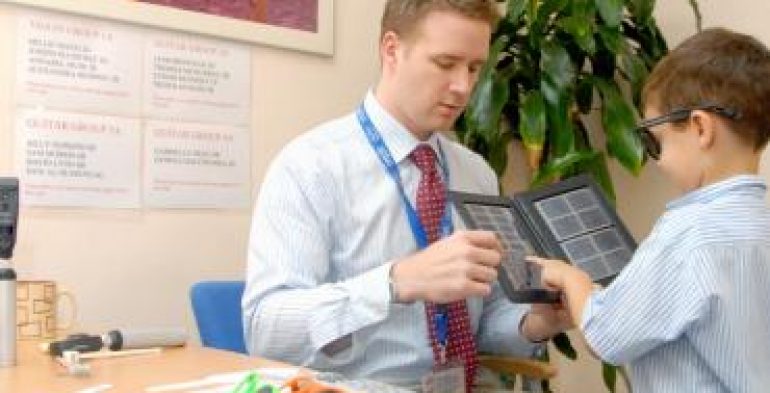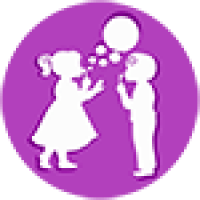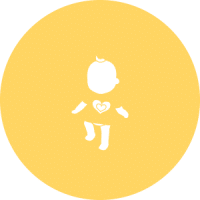
The main challenge of paediatric ophthalmology compared to other branches of ophthalmology is examining children. Adults can read the letters on the vision chart and tend to cooperate fully with their assessment so you can get all the information you need to make your diagnosis very easily. Children on the other hand may be too young to know their letters, may have a short attention span and may be scared and uncooperative.
My job, and the job of the team of eyecare professionals who work with me, is to get as much information as possible about the child’s vision and eye health with as little stress for the child and family as possible. For the tiniest children I try to make as much of the examination as I can like a little game and I chat to them gently and sing nursery rhymes.
Communication is also very important – parents often have a higher level of anxiety about their children’s eyes than they would about their own and it is important to be able to reassure and explain fully. The children too need to have a simple explanation that they can understand at their own level – especially when their cooperation is important for treatment (letting someone put eye drops in, wearing spectacles or an eye patch for instance).
All areas of medicine evolve constantly and it is important to keep updating our knowledge and skills. Medical conferences bring the newest research and development to our attention. We were lucky enough to have the World Ophthalmology Congress in Abu Dhabi early this year – the whole of ADNEC was filled with thousands of ophthalmologists from all over the world with hundreds of high quality sessions covering every conceivable special interest within ophthalmology.
The internet is also a great resource for access to medical journals and educational modules and for professional discussion groups where specialists from all over the world can offer their views on clinical challenges. The main reward of paediatric ophthalmology is that you know that the difference you can make by treatment when your patient is a child may last them a lifetime.
How good is your eyesight? This can be a difficult question to answer for adults but at least they can rely on years of experience and testing; for a child or a parent of a child, this can be a much more difficult challenge. For a child who has no experience and believes his/her vision to be ‘normal’, then it is almost impossible for them to discover a problem without a test. And the earlier the better.
Regular eye tests for children are essential – they are also quick, simple and painless and can help prevent serious vision related problems in later children or in adulthood. They can also pick up current problems that may be inhibiting the child’s development at school and performance in the classroom; it is surprising how many ‘disruptive children’ at school turn out to have a vision problem that is distracting them in the classroom.
Here is a 10-point check list for parents:
1. Does my child need a regular eye test?
The answer is very simple; yes! Every child between 4 1/2 and 5 1/2 years of age should have an eye test (this is sometimes done in schools by the nurse but if your children have not had a test at school then parents should make separate arrangements).
2. What if the need is more urgent?
For some children, the need for an eye test may be more urgent, for example any child who develops a squint (turn) in the eye or any child with a droopy eyelid should have an eye test when the problem is noticed. Any child with a close relative who has a squint or lazy eye should be examined when they are about 3 years old.
3. What other symptoms should we look for?
Other common symptoms of eye problems in children include headaches – your child should have an eye test because headaches can be caused by long-sight, unbalanced eye muscles and by inflammation in the eye.
4. How common are eye problems in children?
Eye problems in children are relatively common – one of the most common eye problems is amblyopia (also known as lazy eye) which happens in up to 5% of all children.
5. Can’t we see if there is a problem?
Not all eye problems are visible – Amblyopia can be caused by a squint (crossed eye) in which case the squint will generally be visible but it can also be caused by problems which are invisible to family members. Other problems include conjunctivitis, blocked tear ducts, droopy eyelids, eyelid cysts and allergies.
6. Do eye problems run in families?
Some eye problems like squint (crossed eyes), amblyopia (lazy eye) long sight and short sight do commonly run in families. If a parent, sibling or cousin has one of these problems, a child should have an eye test with an experienced eye doctor – ideally by about three years of age. If there is a rarer genetic disease in the family, such as retinoblastoma or congenital cataract, then children should be examined as babies by an eye doctor.
7. Why can’t children tell us, if there is a problem?
Small children who are born with poor vision cannot tell you their vision is poor – it’s a simple fact that children can be unaware that they have a problem and that others have better vision. Of course, if your child tells you they can’t see very well, then an eye test is clearly needed.
8. Are there any other signs to look out for?
Children who may be having difficulty at school – A variety of eye problems can give children difficulty with their school work. Uncorrected long sight (hypermetropia) or eye muscle balance problems may make reading physically tiring and put children off their studies. Myopia or astigmatism may make it difficult for them to see the whiteboard or see what people are doing the other side of the classroom. Kids with poor vision who are undiagnosed can be deemed trouble makers or slow learners…
9. What’s the benefit of testing children’s eyesight?
Most causes of poor vision are easily correctable if they are picked up and treated on time -The human brain is learning to see, from birth until about 7 1/2 years of age and so checking the eyes during this time is important. For example, if there is a problem with one eye that blurs the vision then the part of the brain that processes vision from that eye will not develop properly and instead the brain devotes all its efforts to the other eye. This is called amblyopia or lazy eye. Treatment of lazy eye works better in younger children but is fairly unlikely to work after the age of 7 1/2.
10.Who should do the eye test?
An optician can test the child’s eyesight but for a complete eye health check, visit your ophthalmologist (eye doctor) – a specially trained professional who can give your child the all-clear.
www.moorfields.ae










